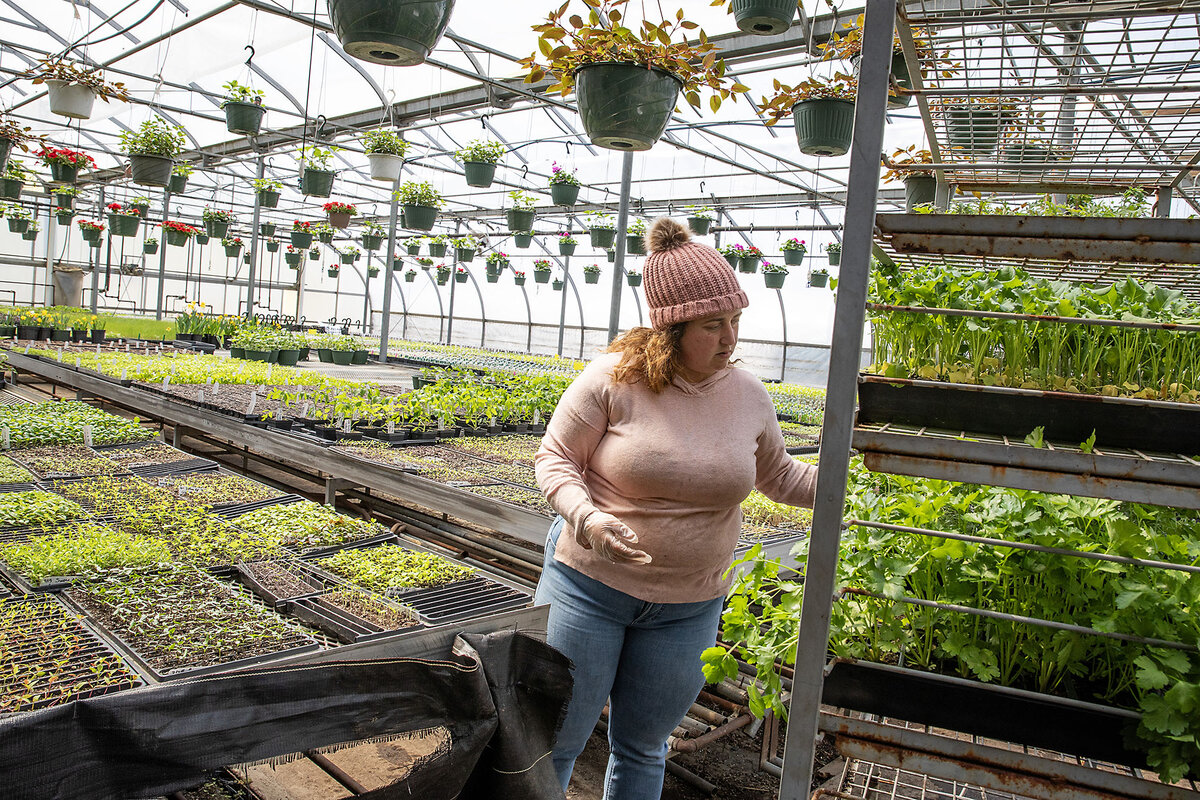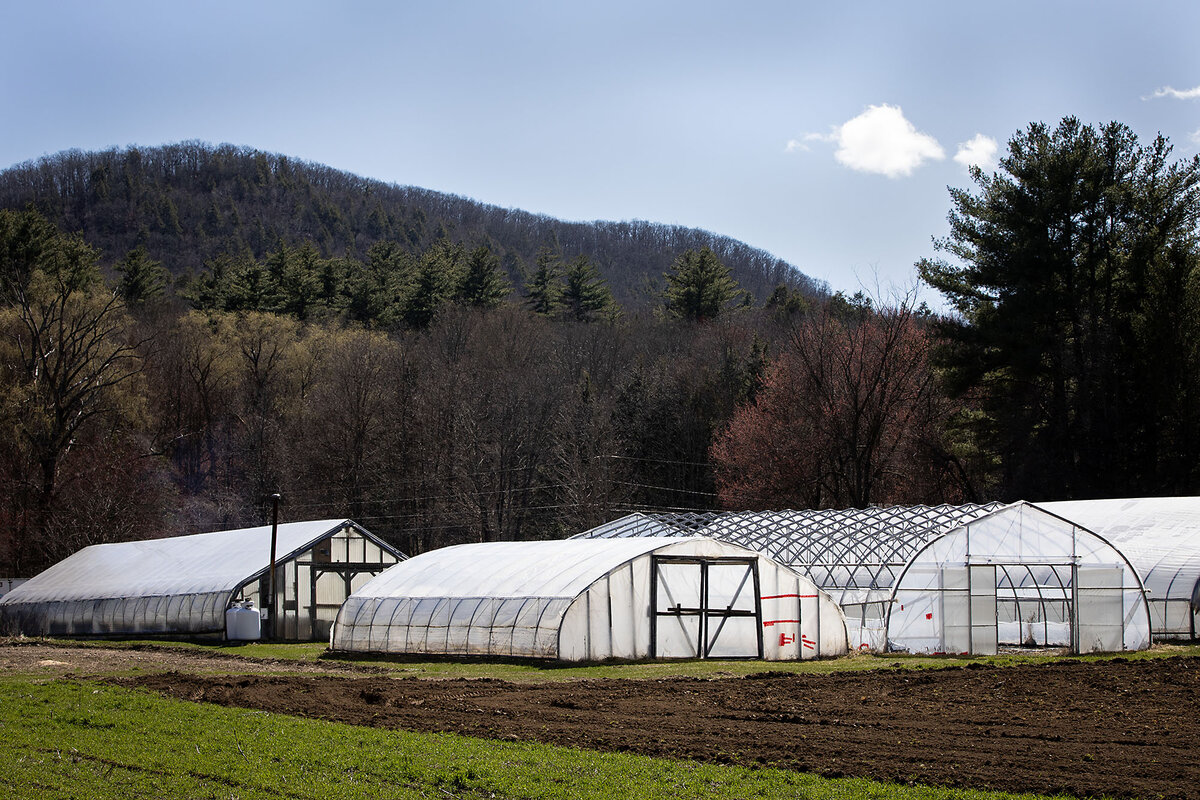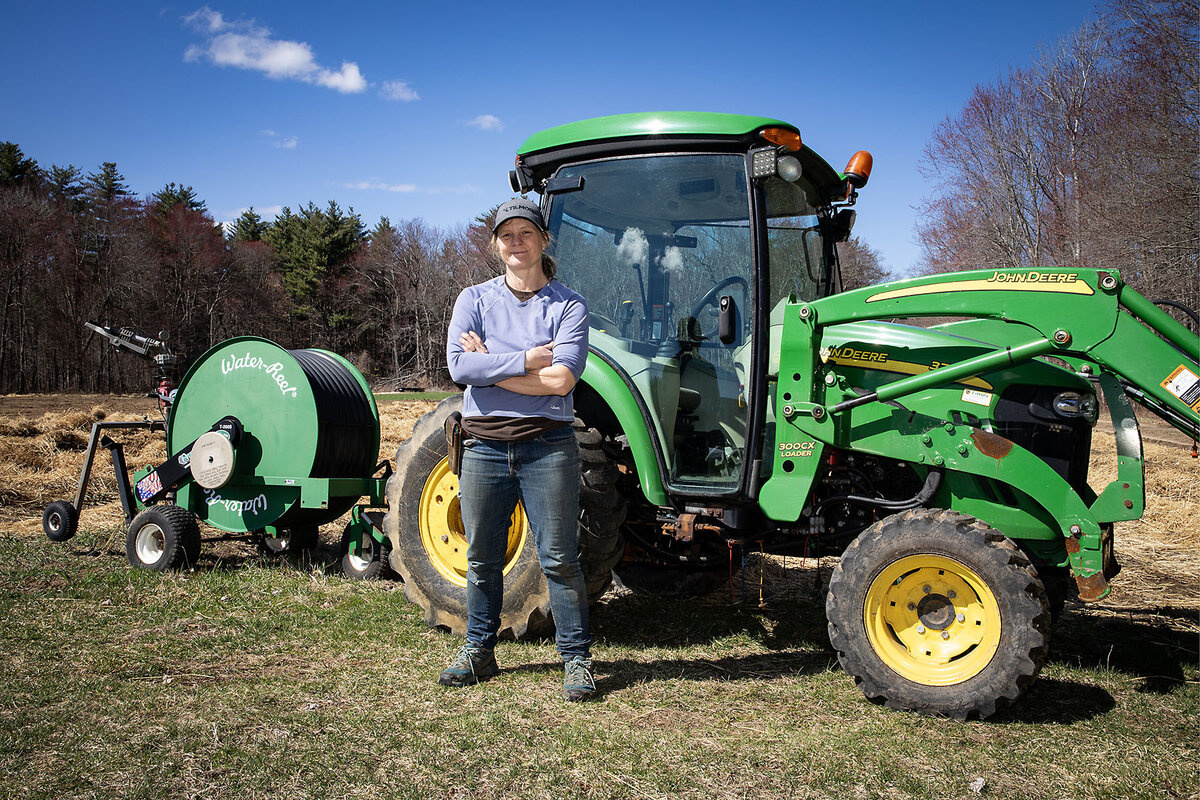Massachusetts loves its small farms. Will that be enough to save them?
Loading...
| Montague and Amherst, Mass.
It took decades for Ryan and Sarah Voiland to expand Red Fire Farm to 200 acres. They renovated an old dairy barn whose massive chestnut beams were held together with wooden pegs. They added a greenhouse, landscaped, and installed a display cooler to create a farm stand. It provided an idyllic backdrop for scores of customers wanting to feel connected to New England farm life as they shop for organic and locally grown carrots and tomatoes.
Then, one February morning in 2024, a call came. The barn was on fire. By the time the Voilands arrived, it was nearly gone.
After the shock wore off, the Voilands got to work, as farmers do, fundraising and applying for grants to rebuild and recover lost equipment and supplies. Setbacks are part and parcel of what it means to be one of 7,000 small-scale farmers in Massachusetts.
Why We Wrote This
A story focused onTo be a small farmer is to embrace uncertainty – even in a state like Massachusetts with lots of farmers markets and community support. But this year’s U.S. Agriculture Department cuts are imperiling a way of life even for the hardy.
“We’re trained to try any and all avenues that we can find to remain viable,” says Mr. Voiland sitting in his Montague office, strewn with papers, fresh spring earth clinging to his boots. “Historically that has involved pursuing grant opportunities wherever we can to take advantage of whatever resources are out there to help keep us going.”
Communities across Massachusetts are used to rallying to support local agriculture in uncertain moments. This is a state where community-supported agriculture (CSA) has thrived and grown for four decades. More than a quarter of its farms sell directly to customers, the second-highest rate after Vermont. Nearly 14% of agricultural sales in Massachusetts are from direct-to-consumer sales – the highest in the nation. The national average is 0.6%. Across the Plains states, where waves of commodity grains roll like a mighty Goliath, the percentage of farmers selling food directly to consumers is below 4%.
“During times of upheaval and chaos people want to know where their food is coming from,” says Claire Morenon, communications manager for Community Involved in Sustaining Agriculture, a program in South Deerfield, Massachusetts, dedicated to growing and strengthening local food systems. “People look to their own communities and think, ‘What can I do to have an impact? How can I make a decision to support my local community?’”
Farmers in Massachusetts are launching their growing season – determining which crops to plant, reviewing what farm projects to pursue, and planning budgets. The funding freezes and staff cuts at the U.S. Department of Agriculture, combined with a drastic reduction of Massachusetts Supplemental Nutrition Assistance Program (SNAP) dollars at farmers markets, have left farmers feeling even more vulnerable in an industry full of risks and increasing costs. There are early signs of stress, but the full impact of the loss of government support is still to be felt. Red Fire’s profits at winter farmers markets that serve lower-income neighborhoods, which depend on government vouchers to buy fresh produce, dropped by half, Mr. Voiland says.
So many small Massachusetts farms like Red Fire Farm live on the edge, says Clem Clay, director of the University of Massachusetts extension agriculture program in Amherst.
“Even in the so-called best of times, they’re only maybe a year away from disaster,” he says. “There’s a squeeze on profitability that’s built into the economic structure for a lot of these farmers. ... It’s not hard to find stories of a farmer who everybody thought was doing well and who went out of business in the last few years.”
Planning the new barn site has been a huge undertaking that could eventually cost over a million dollars. But the Voilands are used to setbacks, like the unusual deep freeze in February 2023 that wiped out their peach, pear, and apple crops.
Small farms can’t rely on crop insurance the way that large-scale commodity farms do, Mr. Clay explains.
“I would say for the majority of smaller farmers ... there isn’t that kind of safety net that comes from having crop insurance. Nor is there that kind of safety net from knowing that if you grow corn or soybeans or something that gets a lot of attention on the national stage, so that if you get affected by tariffs, you might get a bailout or something like that,” he says. “Our farmers have no particular reason to expect a bailout if some policy or economic wind shifts to their disadvantage.”
A flicker of hope stirred last year when the Voilands received approval for a federal Rural Energy for America Program (REAP) grant to put toward building a large solar canopy on the site of the burned-down barn. The structure would store tractors, fertilizers, and pallets of seeds while lowering electrical costs.
But then, on Feb. 13, 2025, the Department of Agriculture issued a funding freeze on four federal programs that are the lifeline for small farms. The response in the Northeast was equally swift. Sen. Cory Booker of New Jersey, a Democrat, introduced the Honor Farmer Contracts Act. The Maine attorney general sued the Trump administration on behalf of children in schools and child care centers. Earthjustice, an environmental law organization, filed a federal lawsuit on behalf of three nonprofits and five small farms, including Red Fire Farm, whose REAP grant for solar arrays was halted.
“All these programs are being cut away that were very essential pieces to making a local farm economy possible,” says Mr. Voiland.
In a profession full of unknowns, added uncertainty will likely impact a farmer’s attitude toward business expansion or investment in climate mitigation measures like renewable energies, says Mr. Clay.
“Any rational farmer is going to be more cautious right now, if they were expecting federal support for some part of the costs for those things,” he says.
At Brookfield Farm, a short drive from the town center of Amherst, farmer Kerry Taylor is almost reluctant to admit that this year their CSA shares – a prepurchased portion of a farm’s harvest – are so in demand that they have added more.
“It’s a terrible business climate to be operating in right now, but our sales are up. Historically in times of uncertainty, our shares do well,” says Ms. Taylor.
Brookfield Farm is a nonprofit and its entire budget comes from CSA shares. They don’t rely on funding from the Local Food Purchase Assistance Cooperative Agreement, one of the Massachusetts programs that lost USDA funding in a sweep of cuts amounting to $12.2 million, according to Gov. Maura Healey. In fact, Brookfield Farm donates a percentage of their crops to feed the hungry, in addition to private fundraising for food pantries.
But Brookfield still depends on grant money to keep the 40 tillable-acre farm running smoothly. A food security infrastructure grant through the Massachusetts agriculture department will help renovate the root cellar and buy a refrigerated delivery van. That only covers this year’s needs.
“There is so much uncertainty, and it’s very chaotic and confusing. It’s not great for farmers who are planning production well ahead,” says Ms. Taylor, who organized a farmer rally in late March in Hadley, Massachusetts, that attracted about 300 people. “We needed to speak up and do it fast.”
Recent rumblings suggest that the USDA may let some grants proceed if the grant recipients are willing to remove “harmful,” “far-left” language from their grant applications by April 25. Mr. Voiland of Red Fire Farm asked for clarification from his contacts at the USDA grants office. It took weeks to get a response. The vague reply was that the funding is yet to be allocated.
But the tender green sprouts pushing through the earth at Red Fire Farm don’t know anything about that. Mr. Voiland checks on a high tunnel of tomato plants that survived plummeting overnight temperatures thanks to a propane heater. Farm workers in a greenhouse plant tiny kale and marigold seeds into plastic trays, while others harvest leafy bunches of spinach. The smell of crushed cilantro wafts up from the rows.
They’ve lost this year’s peach crop to frozen black rot. And Red Fire Farm will only be allocating 85 acres to grow their staple produce this year, down from 125 acres.
“It’s good to see things growing again,” says Mr. Voiland, as his brow furrows.









